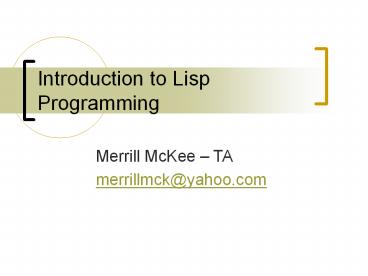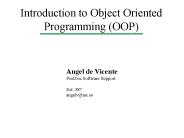Introduction to Lisp Programming - PowerPoint PPT Presentation
Title:
Introduction to Lisp Programming
Description:
Lisp programmers love Lisp 'Perhaps I like Lisp because of some ... Cygwin or Unix/Linux prompt. Emacs. Getting Started - Examples. Numeric Literals. Characters ... – PowerPoint PPT presentation
Number of Views:1853
Avg rating:3.0/5.0
Title: Introduction to Lisp Programming
1
Introduction to Lisp Programming
- Merrill McKee TA
- merrillmck_at_yahoo.com
2
Why learn about Lisp?
- Lisp programmers love Lisp
- Perhaps I like Lisp because of some quirk in the
way my brain is wired. Peter Seibel - Still used in industry
- As extendable and as fast 1 as other languages
- Stable, powerful
- Web, GUI, open source libraries
- Read-eval-print loop (REPL)
- NASAs 1998 Deep Space 1 mission
- Common in Artificial Intelligence
- PhD qualifying exam
- Or just for your grade on homework 2 and COP
4020 exams
References on last slide
3
Common Lisp
- Common Lisp, a dialect of Lisp, is the language
specification that was attempted in the 1980s to
standardize existing Lisp variants - Scheme
- Later standardized by ANSI X3.226-1994
- Your homework assignment will be done in Common
Lisp
4
Getting Started (link for more info)
- Countless Lisp development environments
Cygwin or Unix/Linux prompt
Emacs
Lispworks
Eclipse w/ plugin
5
Getting Started - Examples
- Numeric Literals
- Characters
- Strings
- Functions
- Functions
- Macros
- Special Operators
6
Numeric Literals
7
Oops (the debugger)
8
Defining Functions
- Fundamental building block for Lisp programs
- Most common type of Lisp test question!
- Define a function that
9
History of Lisp
- Created by John McCarthy in the late 1950s
- Published in 1960
- Championed mathematical logic to study artificial
intelligence - Main idea was to study computability from a
functional programming standpoint - Common Lisp now supports object oriented,
imperative, and functional programming
10
Lambda Calculus
- Invented by Church and Kleene in the 1930s
- Can be used to define what a computable function
is - Influenced functional programming languages such
as Lisp, ML, and Haskell - f(x) x 2 or lambda x . x 2
- Binds functions to names
- Gives a natural representation for recursion
11
Lisp Lambda Functions
- (lambda lambda-list body)
- Similar to lambda calculus expr.
- lambda x . x 2
12
Fundamental Data Types
- Two fundamental data types
- Atoms
- An atom is an alphanumeric string, used either as
a variable name or a data item - Lists
- A list is a sequence of elements, where each
element is either an atom or a list - Common Lisp also provides
- Vectors
- Hash tables
- I/O
- Arrays and Multi-dimensional arrays
13
The Interpreter
- In 1965 McCarthy developed a function called
eval used to evaluate other functions (an
interpreter). - It is a read-evaluate-write infinite loop.
- Expressions are interpreted by the function
eval. - Literals are evaluated to themselves. For
example, if you type in 5, the interpreter will
return 5. - Expressions that are calls to primitive functions
are evaluated as follows - Each parameter is evaluated first.
- The primitive function is applied to the
parameter values. - The result is displayed.
14
Eval Function
15
Sample Problems
- What do the following evaluate to?
- (Use your intuition and guess. No grade here.
In the spirit of the class, please come up with
an answer before using your laptop to find a
solution.) - ( (3 2))
- (if (lt 2 3) (print Yes) (print No))
- (if (lt 2 3) (print 1) (print 2) (print 3))
- z
- (x 1 foo) or (x 1 foo)
- ()
- ( 1)
- (dotimes (x 2) (print x))
- (null nil)
- ()
- (sort (1 2 3) gt)
- (eq 1 1.0) .. (eql 1 1.0) (equal 1 1.0)
(equalp 1 1.0)
16
Binding Names to Functions
- Define or defun is used to bind a name to a
value or a lambda expression. - Depends on the Lisp environment
- Format
- (defun (function_name parameters)
ltexpression(s)gt) - Formally - defun name lambda-list
declaration doc-string form - Example
- (defun (square num) ( num num))
17
Binding Names to Functions (cont)
- Once the function is evaluated by the
interpreter, it can be used as in (square 7) 49 - Example
- (define (hypotenuse side1 side2)
- (sqrt ( (square side1) (square side2))))
18
Binding Names to Values
- (define pi 3.14)
- (define twopi ( 2 pi))
- Once these two expressions are typed in to the
Lisp interpreter, typing pi will return 3.14. - Names consist of letters, digits, and special
characters (except parenthesis) but cannot begin
with a digit.
19
If
- John McCarthy invented the if-then-else construct
we take for granted. It was incorporated into
Algol. - (if condition then-form else-form)
- The then-form and optional else-form are
restricted to a single lisp form. To create a
code block use the progn function. - Alternatively, use when and unless macros.
20
If (Cond)
- Cond is a macro to handle multiple nested if
statements. - (cond
- (test-1 form)
- (test-n form))
21
If
22
If
23
Setf
- Binds a value to a location/variable
- (setf place value)
24
Sample problem
- How would you reverse a list? Do you have enough
tools yet to define this function? - Without using the built-in reverse function
- (defun reverse-list (list) )
- What do you need?
- Need to get an element from the list
- Need to build and save a new list
- Need to do it in reverse order
25
My-reverse
- http//mwolson.org/notes/wikisource/CommonLispBegi
nnersGuide.muse
26
References For These Slides
- UCF Library about 20-25 books in the QA 76.73
.L23 shelf. - Practical Common Lisp by Peter Seibel
- Common Lisp The Language by Guy
- Steele, Jr.
- Dr. Montagnes UCF COP 4020 Slides
- Websites
- http//mypage.iu.edu/colallen/lp/ concise and
readable - http//www.cs.cmu.edu/Groups/AI/html/cltl/clm/node
1.html extensive but harder to read - http//www.google.com































